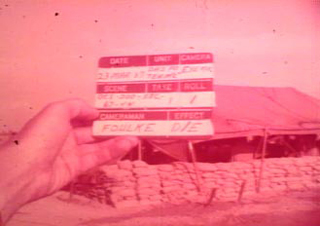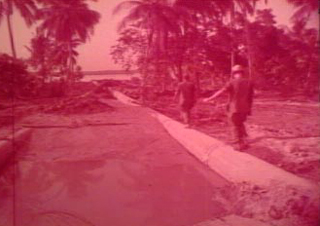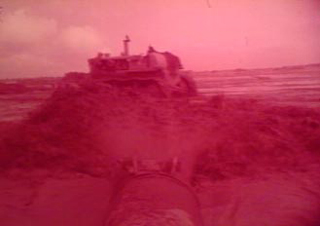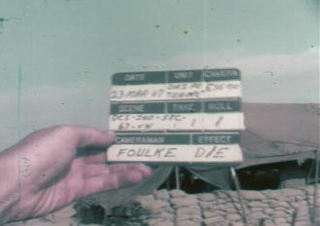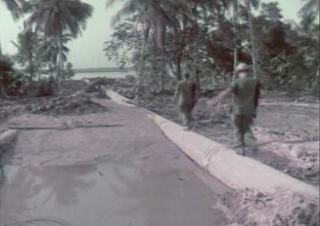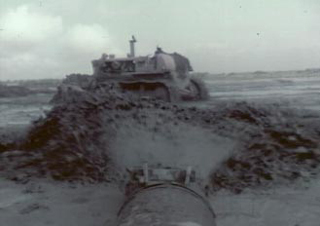Preservation of the "Dong Tam Base Camp" film, from the William Foulke Collection
This film was preserved through a grant from the National Film Preservation Foundation. Film reproduction and color restoration completed by Monaco Digital Film Labs.
Introduction
In March of 1967, while on assignment in Vietnam, DASPO cameraman William Foulke filmed the construction of the base at Dong Tam, along the north bank of the Mekong River, near My Tho. The unedited footage was never used, and before he left Vietnam, Foulke was ordered to destroy it. Instead, he kept the film, and dozens of other films he shot for DASPO in Vietnam. In 2002, Mr. Foulke donated these films to the Vietnam Archive. Archivists soon realized that the films had deteriorated so badly that they were almost unusable and not viewable by researchers. The 16mm, silent, color film had faded to a bright pink. The action of the participants was almost impossible to discern. Without preservation work, the film was in danger of being lost forever.
 In 2005, the Vietnam Archive applied for grant with the National Film Preservation Foundation to fund the preservation copying of William Foulke's "Dong Tam Base Camp" film. Upon receiving the grant award, the Vietnam Archive sent the original film to Monaco Digital Film Labs in San Francisco for preservation work. Monaco labs copied the film, created a new internegative , a new print, and a color corrected Digital Betacam copy. The results of this preservation work can be seen below, in still images, and through links to the two versions of the film.
In 2005, the Vietnam Archive applied for grant with the National Film Preservation Foundation to fund the preservation copying of William Foulke's "Dong Tam Base Camp" film. Upon receiving the grant award, the Vietnam Archive sent the original film to Monaco Digital Film Labs in San Francisco for preservation work. Monaco labs copied the film, created a new internegative , a new print, and a color corrected Digital Betacam copy. The results of this preservation work can be seen below, in still images, and through links to the two versions of the film.
The Construction of the Dong Tam Base Camp
With the war in South Vietnam expanding, MACV realized the necessity of retaining control of the population of the Mekong delta and its vast agricultural resources for the Government of Vietnam. By early 1966, MACV believed US soldiers and sailors needed to assist the Army of the Republic of Vietnam in securing the delta from the growing communist insurgency. A base from which an entire US infantry division could operate was essential. The Mekong delta contained nearly half of the entire population of South Vietnam and space for constructing a base to headquarter an American infantry division in the region was very limited. MACV did not wish to displace any South Vietnamese residents, nor did they wish to share any existing space in the delta with ARVN troops. Instead, MACV charged Army engineers with finding a suitable space upon which to construct a base. The engineers found a possible location eight miles west of the delta town of My Tho. The engineers proposed dredging river sand and silt into a vacant rice paddy in order to provide enough space upon which to construct a base. Dredging began in August, 1966, and General William Westmoreland named the new base Dong Tam. Dong Tam translated from Vietnamese into united hearts and minds and reflected the spirit of cooperation between the United States and the Republic of Vietnam. By April, 1967, construction was nearly complete. The engineers dredged around eight million cubic meters of sand to create a space approximately one square mile in size. Engineers raised the land in the area between five and ten feet in order to prevent flooding during high tides and during the rainy season. Dong Tam served as a headquarters for the US Ninth Infantry Division while it operated in the Mekong delta and provided the US Navy with permanent repair facilities for riverine craft.
William Foulke
William Foulke spent thirteen years as an Army photographer and cameraman, including three years in South Vietnam. He began his military career at the Army Pictoral Center in New York City in 1965, then served in the DASPO Pacific Detachment headquartered in Hawaii in 1966 and 1967. He was assigned to the 221st Signal Company/Military Assistance Command, Vietnam (MACV) in Saigon until 1969, and returned to DASPO in 1971. At various times in his service, Foulke was assigned to film destruction, where he regularly salvaged unclassified, raw, unedited footage filmed by himself and other DASPO photographers. Since the Vietnam Archive became the official archival repository for the DASPO Combat Photographers' Association in 2002, Mr. Foulke has donated 39 reels of 16mm film, over 1000 slides and photographs, and over one linear foot of administrative documents and typewritten reminiscences produced during and after his DASPO career. Mr. Foulke currently resides in Midland, Texas. (view the finding aid of the William Foulke Collection)
Department of the Army Special Photographic Office (DASPO)
Created in 1962, the purpose of the Department of the Army Special Photographic Office was to provide documentary films and still photographs to the US Army, Pentagon, and the Joint Chiefs of Staff. In 1968, a permanent unit was stationed in Saigon to cover military activities in Vietnam. When on assignment, DASPO teams operated much like civilian journalists covering the war, but with much greater access to ground operations of U.S. Army troops. Their commanding officers assigned them to cover a wide range of Army activities, often filming side by side with soldiers in combat situations. (view the finding aid of the DASPO collection)
Vietnam Center & Sam Johnson Vietnam Archive
-
Address
Texas Tech University, Box 41041, Lubbock, TX 79409 -
Phone
(806)742-9010 -
Email
vnca@ttu.edu

